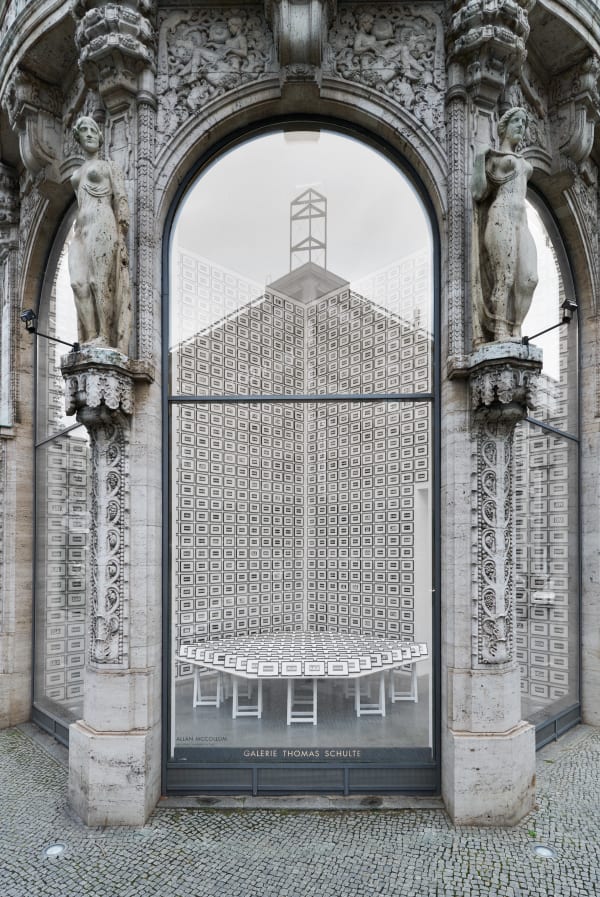THE WORLD: A MOMENT IN TIME: Allan McCollum
-
Introduction
With The World: A Moment in Time (2024), Allan McCollum revisits his sweeping, poignant installation Each and Every One of You (2004) —marking the occasion of the work’s 20th anniversary. Presented by Galerie Thomas Schulte for the first time in Germany, the new work takes a more expansive view, adapting to shifts in the geo-political landscape and societal discourses of the two decades since its initial conception.
Like its predecessor, The World: A Moment in Time comprises 1.200 framed digital prints, each containing a different given name. It departs from the first iteration, however, in two significant ways. For the original work, McCollum drew on data from 2004 from the U.S. Census Bureau, compiling names commonly used in the country at the time and breaking them up according to the 600 most popular female names and the 600 most popular male names. In contrast, the new work is a collection of the most common names worldwide and forgoes distinctions based on gender—resultantly absent of binary classifications or any other breakdown into discrete categories. Within this constellation, the prominent occurrence of names, for example, of Chinese, Hispanic, Indian, or Muslim origin, also visualizes current demographic statistics. In updating the work in this way, McCollum reflects on its place in an increasingly global society, while considering topics of inclusivity within the contemporary art context in which it is situated—and beyond.
The prints are identically formatted and hung closely together in a panoramic whole. Side by side, row by row, they form a dense grid that consumes the display architecture almost entirely. The shapes of white letters outlined against a black background—as though emptied out or still to be filled in—are strung together in a broad tapestry. Incessant regularity and sober order make this accumulation of objects appear at once overwhelming and highly controlled. But there are evident distinctions: scaled to fit the same image size, shorter names are made up of larger letters, highlighting changes from frame to frame and generating a certain rhythm. The white mats around them also keep them insulated inside of their autonomous black frames—marking a clear separation. Every single one is the same and yet each is its own.
The sense of intimacy afforded by the small size of the prints is curtailed by the distance and impersonal nature of the work’s scale and mass-produced sameness. And yet—although a name’s appearance in the installation is an indication that it is not unique—individuality is underscored by virtue of the singular presence of a name within this vast sea of many others, at the same time as possibilities for finding connection are opened up.
There is a collective emotional investment in the act of giving names. Maybe we grow attached to something only after we have named it; we give ourselves names that fit our identities; or we share a name with those we are connected to. In the space of this installation, perhaps we instinctively seek out our own names or those of friends and family—like rummaging through collections of personalized knick-knacks at a souvenir shop. In their straight-forward manner, the prints also resemble name cards or tags, for example, used for attendees and participants of a large-scale event. They could be markers for people who are not there: those who have not yet arrived or else have already departed. In their pared down black-and-white simplicity, we might sense a certain somberness—like standing before a monument on which a list of names have been etched in remembrance—or find ourselves flooded with personal memories and associations, like opening an old address book.
Beyond offering portraits of individuals, it is the emblematic nature of the names assembled here that contributes to a portrait of a particular moment. The title of the new work, The World: A Moment in Time, puts an emphasis on its own transience, even as it indicates a totalizing view. Through simultaneous modes of inclusion and reduction, it is a tangible imagining of the sheer scope of something that is otherwise difficult to conceive of. What we are presented with is a sort of abstraction of the world, a snapshot that we are invited to enter into—or are likely already a part of. It may represent a specific moment, already passed, but its potential iterations are without end, continuously unfolding through our individual and collective encounters.
Text by Julianne Cordray -
Installation Views
-
Works
-
Inquire about works by Allan McCollum
-
Artists on view



